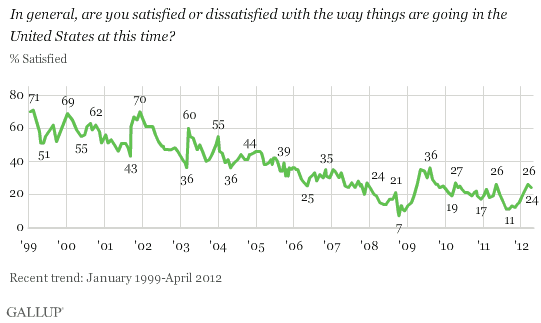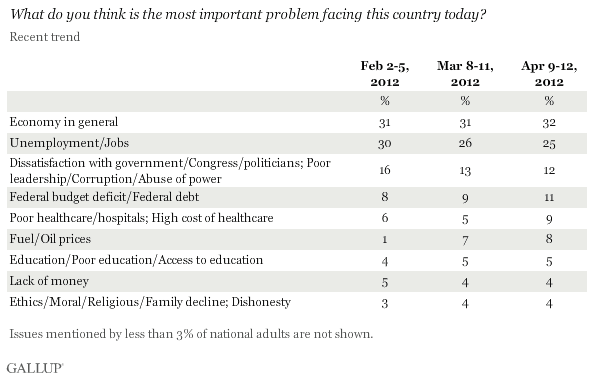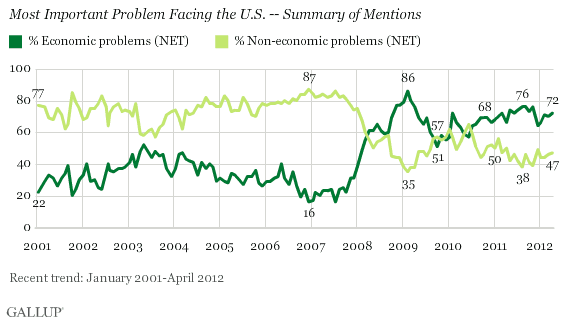PRINCETON, NJ -- Americans' satisfaction with the way things are going in the country leveled off in April at 24%, slightly lower than March's 26%. Satisfaction remains higher than in any month in 2011 except May, and substantially higher than the recent low point last summer of 11%

Although the latest satisfaction rating of 24%, measured in Gallup's April 9-12 survey, is two percentage points lower than March's 26%, it reflects a generally more positive public than was the case for most of last year. Americans' satisfaction now is also exactly where it was in January 2008, just as the full impact of the recession began to hit home to Americans.
The all-time low point for satisfaction in Gallup's history is 7% in October 2008. Satisfaction rose into the 30% range after Barack Obama's inauguration as president in early 2009, and then over time dropped to 11% in August and September of last year.
From a longer-term perspective, Americans' satisfaction reached its all-time high of 71% in February 1999, toward the end of the dot-com boom of the late 1990s, and hit 70% in December 2001, part of the rally effect that followed the 9/11 terrorist attacks and the introduction of U.S. troops into Afghanistan. Satisfaction gradually drifted downward from that point until 2008, with occasional upward surges such as accompanied the capture of Saddam Hussein in late 2003.
Economy Remains Americans' Top Concern
As has been the case in recent months, a little more than three in 10 Americans (32%) say the "economy" is the most important problem facing the country, followed closely by unemployment/jobs (25%).
The percentage of Americans mentioning gas or fuel prices is at 8% in April, up only one point from March, thus suggesting no dramatic upsurge in public concern about gas prices, at least as measured by this metric. Americans also were slightly more likely to mention healthcare issues (9%) this month than last (5%), perhaps reflecting the news focus on the Supreme Court's late March review of the constitutionality of elements of the 2010 Affordable Care Act.
The top non-economic concern Americans mention is dissatisfaction with Congress and government (12%).

In general, Americans are significantly more likely to mention economic concerns than non-economic concerns in response to the "most important problem" question -- as they have been consistently for the past two years.

Bottom Line
While Americans' satisfaction with the way things are going in the U.S. slid slightly in April, it remains higher than it was in all of 2011, with the exception of May -- a reading that most likely reflected the short-term positive reaction to the death of Osama bin Laden.
Satisfaction with the way things are going in the country is one . Presidents George W. Bush in 2004 and Bill Clinton in 1996 enjoyed satisfaction levels in or near the 40% range just prior to their successful November elections. George H.W. Bush was unsuccessful in his re-election bid, with satisfaction levels in the 14% to 22% range in the summer of 1992.
As far as the issues on the minds of voters are concerned, the message is clear -- the economy overwhelmingly remains the top problem that Americans are concerned about, far ahead of non-economic issues such as the way government works, healthcare, and the price of gas.
Survey Methods
Results for this ÆéûÜǨû§poll are based on telephone interviews conducted April 9-12, 2012, with a random sample of 1,106 adults, aged 18 and older, living in all 50 U.S. states and the District of Columbia.
For results based on the total sample of national adults, one can say with 95% confidence that the maximum margin of sampling error is ôÝ4 percentage points.
Interviews are conducted with respondents on landline telephones and cellular phones, with interviews conducted in Spanish for respondents who are primarily Spanish-speaking. Each sample includes a minimum quota of 400 cell phone respondents and 600 landline respondents per 1,000 national adults, with additional minimum quotas among landline respondents by region. Landline telephone numbers are chosen at random among listed telephone numbers. Cell phone numbers are selected using random-digit-dial methods. Landline respondents are chosen at random within each household on the basis of which member had the most recent birthday.
Samples are weighted by gender, age, race, Hispanic ethnicity, education, region, adults in the household, and phone status (cell phone only/landline only/both, cell phone mostly, and having an unlisted landline number). Demographic weighting targets are based on the March 2011 Current Population Survey figures for the aged 18 and older non-institutionalized population living in U.S. telephone households. All reported margins of sampling error include the computed design effects for weighting and sample design.
In addition to sampling error, question wording and practical difficulties in conducting surveys can introduce error or bias into the findings of public opinion polls.
View methodology, full question results, and trend data.
For more details on Gallup's polling methodology, visit .
